

I especially wanted to visit Mont Saint Michel, which I'd read about in high school -- in one of Richard Halliburton's travel books, I think. It was the tour I was most looking forward to.

Here's a shot from a bus early in the morning, on the way to Mont Saint Michel. There's the Eiffel Tower in the background. This is one of the few times I saw it in the daylight.

We also passed by the Arc de Triomphe. But not too close by. The road around it is under construction.

Just look at all the paving stones. I noticed they were being installed in exactly the same pattern used with the paving stones between the East and West Wings of the National Gallery right here in Washington, DC. I walk over stones just like these every day I go to work. You can see the pattern in the lower left corner of the picture.
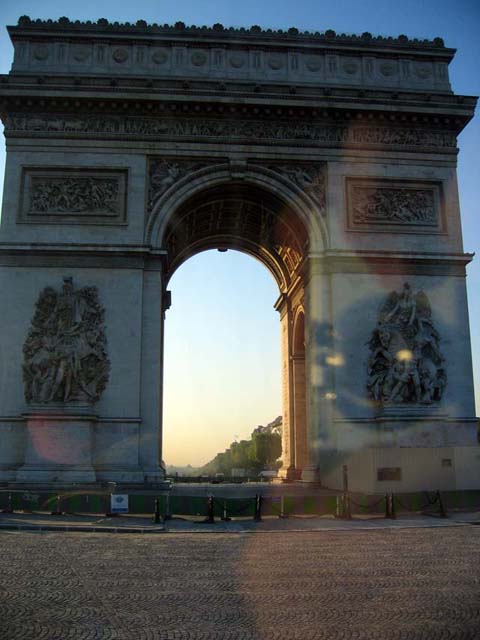
This was my only visit to the Champs Elysées.

This was the longest tour of the trip. We left Paris at 7:00 am and returned around 10:00 pm. We stopped along the way for lunch at this little hotel. The food was OK, but still pretty much cafeteria food. There are many things I like about guided tours of foreign countries, but one thing I don't like is the quality of the food you get.

A French horse farm.

A French house with a thatched roof. We spent most of the day traveling through Normandy -- field after field of corn and wheat and pastureland filled with dairy cattle. We saw apple orchards where they make apple cider and Calvados, an apple brandy. Normandy is a rich agricultural region -- very beautiful.
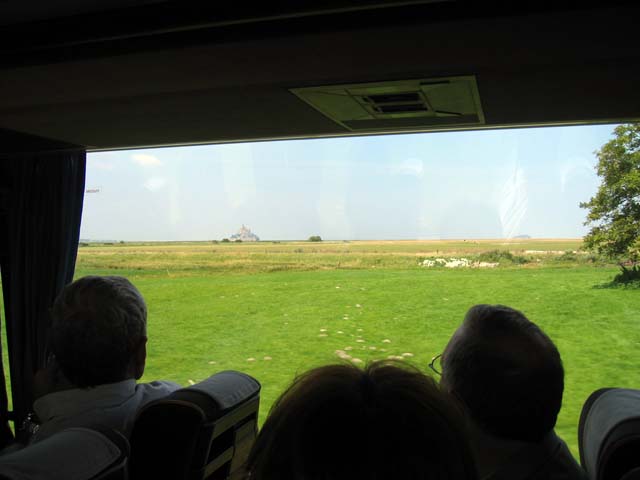
Our guide told us to look to the right of the bus for our first glimpse of Mont Saint Michel. And there it is, off in the distance, rising from the flat terrain like a giant space ship plopped down in the middle of nowhere.

Closer now, and the details begin to emerge.

And there it is, Mont Saint Michel, built between the 11th and 16th centuries, begun as an abbey, turned into a prison, and now a tourist attraction.

And quite an attraction it is.
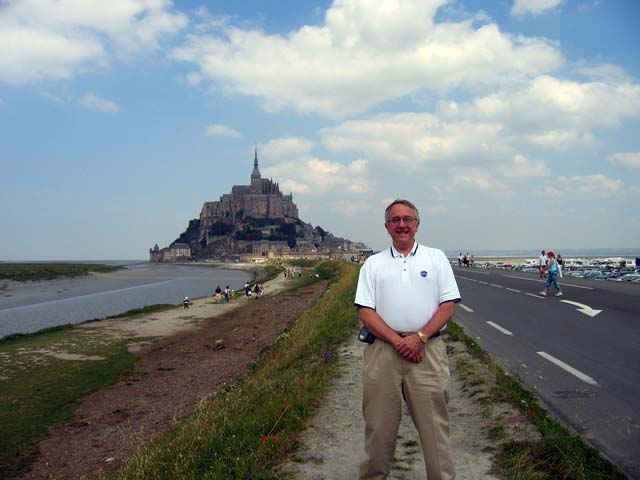
Ignore that guy standing in the way, and look on either side of the causeway. The road was built in the late 1800s. Before that, the tide would come rushing in, completely surrounding the abbey. And when the tide pulled back, it left nothing but mud flats all around. It made Mont Saint Michel a difficult place to get to, and that was the point.

One feature of the tour came as something of a surprise to a few of the less athletically inclined in our group: the steps. Seems there were no accessibility laws in medieval France, thus no elevators, escalators, or even wheelchair ramps. Just steps. Lots of steps. Many many steps. I told our guide there were almost as many steps at Mont Saint Michel as there were leading up to Sacre Coeur back in Paris. She just laughed. And puffed a little.

Lots of steps.

But the view was worth it. That's Brittany off to the right of the little river, and Normandy to the left. And note all the cars and buses. Mont Saint Michel is a very popular tourist destination.

It was a long way to the top.

We saw lots of people scraping mud from their bare feet. They'd been out walking in the mud flats.

Normandy, I'd like you to meet Brittany.

Mud walkers.

Photoshop made this scene look much more golden than it really was. But it's a pretty picture, so here you are. The mud flats were really more of a greenish gray.

There's Saint Michael (Saint Michel) on top of the spire. He was placed there by a helicopter in 1986.

This viewing area has been here since the middle ages.

The workers who built it were paid by the stone, so they carved their numbers into the rocks to ensure they got all the money they deserved.

That's closer to the actual color of the mud flats. Greenish gray.

They say that when the Atlantic tide comes rushing in, it's like a thundering herd of horses. The tides, of course, are affected by the moon, and apparently there are two weeks of tides followed by two weeks without tides. We were there when there were no tides. Still, at one point during our visit, I heard loudspeakers repeating in one language after another that anyone out on the flats should hurry to safety because the water was rising. But it didn't rise. I don't know what that was all about.

Have I mentioned it was a beautiful day? I just couldn't resist the temptation to take picture after picture.

Because of the limitations of the location, the abbey's architects couldn't use flying buttresses to hold up the walls. So they had to settle for wooden ceilings that were lighter than stone and wouldn't cause the walls to buckle.

Like the cathedral at Reims, the old stained glass windows had been lost to time, and had been replaced with translucent glass. Remember, this place was once a prison. Actually it was surprising to me that it has been preserved this well.

There's a nice little courtyard in the middle.

Remember those two chimneys. We'll get back to them in a few minutes.

This is a cloister. Can you imagine all the Benedictine monks walking around in here in total silence?

Fancy stonework.

More courtyard. More cloisters.

This was the refectory, the dining hall. There were benches on only one side of the tables, though. It was thought too tempting to let the monks sit across from each other. Somebody might be tempted to talk.

There's a carving of Saint Michael. His face was knocked off during the French Revolution.
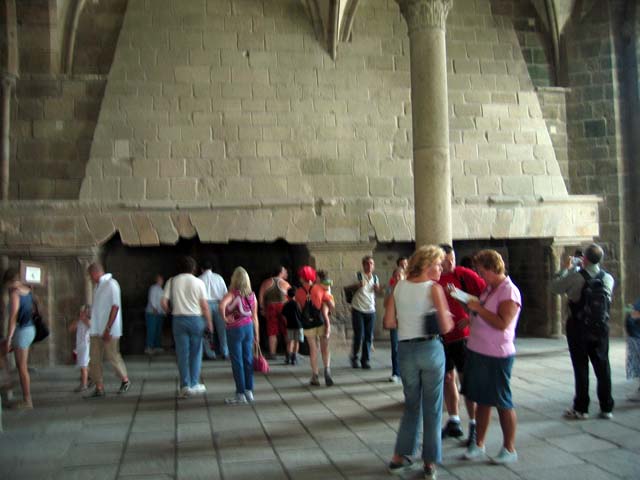
And this is why I told you to remember those chimneys. We're in the kitchen now, which turns out to have been almost the only place of warmth in this cold, damp, isolated abbey. Can you imagine winter out here with no fires for warmth, just robes and gloves and if you're a scrivener, enough heat to keep your fingers limber. Anyway, the cooks were the lucky ones. They got to hang around a big room with huge hot fireplaces, where whole cattle could be roasted. The monks could manage without a lot of warmth, but they still needed food.

But sometimes the monks had to entertain distinguished visitors, so they built this flue from the kitchen to a guest room above where kings and queens and other dignitaries could enjoy relief from the cold.

So how did they bring all the food and other supplies up into the abbey? Carry everything on their backs up the steps? Nah ... they had a special system. See that big sled hanging on the wall?

Well the sled was attached by a rope to that big wheel and lowered down a track from the abbey to the bottom of Mont Saint Michel.

And the wheel was powered by prisoners walking inside.

Like hamsters in a cage, they pulled supplies up from below.

Hauling the sled with that rope.

Up and down that almost-vertical track.

There's Saint Michael on his steeple again.

More mud flats. You know, after a while, the beautiful view from Mont Saint Michel might have become just a bit boring for the monks.

But not the tourists.

Even from the beginning, pilgrims coming to Mont Saint Michel wanted to take home souvenirs. So these shops are merely the latest incarnations of an old tradition. A medieval street crowded with shops and pilgrims.
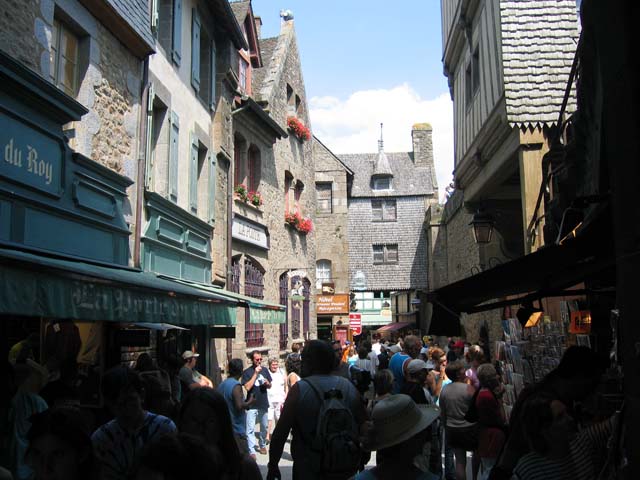
Looks like a set from the movie "Frankenstein."

Getting ready to leave. I'm waiting by the bus for our group to reconvene.

Have I mentioned there were lots and lots of steps?

And mud flats all around?

That's our bus. A nice modern double-decker.

One last look.

OK, I promise: This is the last picture of Mont Saint Michel.

We stopped at a museum for our dinner. It was a WWII Normandy Invasion museum. We didn't have much time to look around -- we just ate and wandered a bit, and then we left. But it was a very nice museum. I think we weren't too far from the invasion beaches, but we never saw any on this trip.

The museum was impressive. If I'd spent the day at the cemeteries and the invasion sites, I'd have wanted to spend more time here.

A D-Day map was visible through glass in the floor.

And out back was a nice park.

This bridge to the park below is actually significant.

It was a Bailey Bridge.

Still looks pretty heavy to me.

Nice museum.

I met a couple of very nice young ladies from Japan. That's Yuko on the right and Chihiro on the left. They're working in London for a year, teaching Japanese to businessmen. I really enjoyed talking to them -- the conversation made our ride back to Paris much too short.